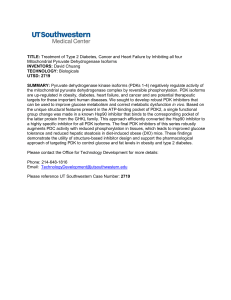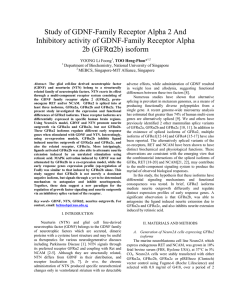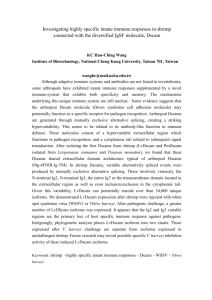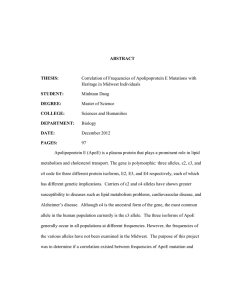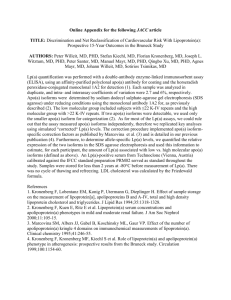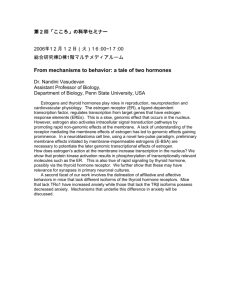findings have raised hopes that GDNF and similar Abstract
advertisement
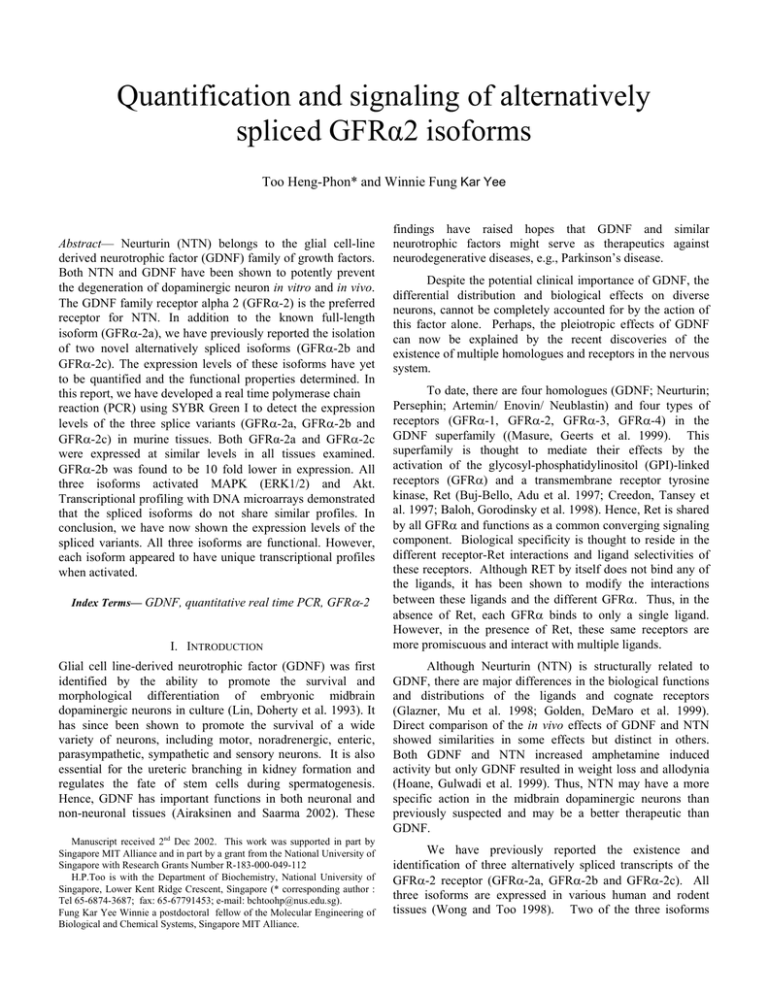
Quantification and signaling of alternatively spliced GFRα2 isoforms Too Heng-Phon* and Winnie Fung Kar Yee Abstract— Neurturin (NTN) belongs to the glial cell-line derived neurotrophic factor (GDNF) family of growth factors. Both NTN and GDNF have been shown to potently prevent the degeneration of dopaminergic neuron in vitro and in vivo. The GDNF family receptor alpha 2 (GFRα-2) is the preferred receptor for NTN. In addition to the known full-length isoform (GFRα-2a), we have previously reported the isolation of two novel alternatively spliced isoforms (GFRα-2b and GFRα-2c). The expression levels of these isoforms have yet to be quantified and the functional properties determined. In this report, we have developed a real time polymerase chain reaction (PCR) using SYBR Green I to detect the expression levels of the three splice variants (GFRα-2a, GFRα-2b and GFRα-2c) in murine tissues. Both GFRα-2a and GFRα-2c were expressed at similar levels in all tissues examined. GFRα-2b was found to be 10 fold lower in expression. All three isoforms activated MAPK (ERK1/2) and Akt. Transcriptional profiling with DNA microarrays demonstrated that the spliced isoforms do not share similar profiles. In conclusion, we have now shown the expression levels of the spliced variants. All three isoforms are functional. However, each isoform appeared to have unique transcriptional profiles when activated. Index Terms— GDNF, quantitative real time PCR, GFRα-2 I. INTRODUCTION Glial cell line-derived neurotrophic factor (GDNF) was first identified by the ability to promote the survival and morphological differentiation of embryonic midbrain dopaminergic neurons in culture (Lin, Doherty et al. 1993). It has since been shown to promote the survival of a wide variety of neurons, including motor, noradrenergic, enteric, parasympathetic, sympathetic and sensory neurons. It is also essential for the ureteric branching in kidney formation and regulates the fate of stem cells during spermatogenesis. Hence, GDNF has important functions in both neuronal and non-neuronal tissues (Airaksinen and Saarma 2002). These Manuscript received 2nd Dec 2002. This work was supported in part by Singapore MIT Alliance and in part by a grant from the National University of Singapore with Research Grants Number R-183-000-049-112 H.P.Too is with the Department of Biochemistry, National University of Singapore, Lower Kent Ridge Crescent, Singapore (* corresponding author : Tel 65-6874-3687; fax: 65-67791453; e-mail: bchtoohp@nus.edu.sg). Fung Kar Yee Winnie a postdoctoral fellow of the Molecular Engineering of Biological and Chemical Systems, Singapore MIT Alliance. findings have raised hopes that GDNF and similar neurotrophic factors might serve as therapeutics against neurodegenerative diseases, e.g., Parkinson’s disease. Despite the potential clinical importance of GDNF, the differential distribution and biological effects on diverse neurons, cannot be completely accounted for by the action of this factor alone. Perhaps, the pleiotropic effects of GDNF can now be explained by the recent discoveries of the existence of multiple homologues and receptors in the nervous system. To date, there are four homologues (GDNF; Neurturin; Persephin; Artemin/ Enovin/ Neublastin) and four types of receptors (GFRα-1, GFRα-2, GFRα-3, GFRα-4) in the GDNF superfamily ((Masure, Geerts et al. 1999). This superfamily is thought to mediate their effects by the activation of the glycosyl-phosphatidylinositol (GPI)-linked receptors (GFRα) and a transmembrane receptor tyrosine kinase, Ret (Buj-Bello, Adu et al. 1997; Creedon, Tansey et al. 1997; Baloh, Gorodinsky et al. 1998). Hence, Ret is shared by all GFRα and functions as a common converging signaling component. Biological specificity is thought to reside in the different receptor-Ret interactions and ligand selectivities of these receptors. Although RET by itself does not bind any of the ligands, it has been shown to modify the interactions between these ligands and the different GFRα. Thus, in the absence of Ret, each GFRα binds to only a single ligand. However, in the presence of Ret, these same receptors are more promiscuous and interact with multiple ligands. Although Neurturin (NTN) is structurally related to GDNF, there are major differences in the biological functions and distributions of the ligands and cognate receptors (Glazner, Mu et al. 1998; Golden, DeMaro et al. 1999). Direct comparison of the in vivo effects of GDNF and NTN showed similarities in some effects but distinct in others. Both GDNF and NTN increased amphetamine induced activity but only GDNF resulted in weight loss and allodynia (Hoane, Gulwadi et al. 1999). Thus, NTN may have a more specific action in the midbrain dopaminergic neurons than previously suspected and may be a better therapeutic than GDNF. We have previously reported the existence and identification of three alternatively spliced transcripts of the GFRα-2 receptor (GFRα-2a, GFRα-2b and GFRα-2c). All three isoforms are expressed in various human and rodent tissues (Wong and Too 1998). Two of the three isoforms (GFRα-2b (Genbank Accession number AF079107) and GFRα-2c (Genbank Accession number AF079108) were novel in structures. The existence of GFRα isoforms (GFRα1a/b and GFRα-2a/b/c) has raised important questions regarding the distributions and expression levels as well as the signaling mechanisms involved. Nothing is presently known of the expression levels of GFRα-2a/b/c. In situ hybridization studies have revealed high levels of expression of GFRα-2 with no discriminations of the isoforms (Burazin and Gundlach 1999). We were interested in the quantitative distributions and the functional properties of the GFRα-2 spliced isoforms. A high throughput quantitative real time PCR assay that can distinguish the spliced isoforms with high specificity was developed and used to quantify the expression levels of murine GFRα-2 in both peripheral and central nervous system. To evaluate the functional properties of these isoforms, transcriptional profiling by DNA microarray and activation of signaling pathway, MAPK-ERK1/2 and Akt, were examined. II. MATERIALS AND METHODS Total RNA of murine tissues and reverse transcription (RT) reaction. Five microgram of total RNA was reversetranscribed with 400 U of Superscript II (Invitrogen, The Netherlands) and random primer (Promega, USA) for 60min at 42˚C as described previously (Wong, Sia and Too 2002). The reaction was terminated by heating at 95°C for 5 min and used directly for quantitative real time PCR using SYBR Green I. Three independent cDNA synthesis were used and measurements were carried out in triplicates. Total RNA were prepared as described previously (Wong and Too 1998) and validated by denaturing agarose gel electrophoresis. Quantitative Real Time PCR. Sequence independent quantitation using SYBR Green I. Real time PCR was performed on the iCycler iQ (Biorad, USA). The threshold cycles (Ct) were calculated using the Optical interface v3.0B (Biorad, USA). Real time PCR was performed after an initial denaturation for 60s at 95oC followed by 40 cycles of 60s denaturation at 95oC, 30s annealing at 60oC and 60s extension at 72oC. Fluorescent detection was carried out at the annealing phase. The reaction was carried out in a total volume of 50 ul in 1x XtensaMix-SGTM (BioWORKS), containing 2.5 mM MgCl2, 0.5 U DyNAzyme II (Finnzymes, OY), 4 or 8 pmol of each primers (Table 1). Standard templates of murine GFRα2a, GFRα-2b, GFRα-2c and GAPDH were generated by RTPCR using the murine designated specific primers encoding the complete open reading frame and subcloned into pIRES (Clontech, Palo Alto) and validated by DNA sequencing. The clones were linearized with Xba I (Promegea, USA) and served as templates of standards for SYBR Green I detections. All real time PCR quantitation were performed simultaneously with plasmids standards and negative control (non-RT samples). The expressions of GFRα-2 isoforms were normalized to the expression of GAPDH. Statistical Analysis. Differences in the expression levels of GFRα-2 isoforms were analysed using paired two-tailed t-test with a level of significance of 0.05 > p >0.02. Western Blot analyses of GFRα-2 transfected cell lines induced by NTN. Mouse neuroblastoma cell line NB41A3 and Neuro2A containing endogenous c-Ret (data not shown) was transfected with GFRα-2a, GFRα-2b, GFRα-2c and pIRESneo independently. The four cell lines were grown and maintained in DMEM with 10% fetal bovine serum under 0.8mg/ml G418 (Sigma) selection. Cells were then seeded in 0.5%FBS/ DMEM/ 0.8mg ml-1 G418 for 24 hours, followed by serum free media (DMEM/ 0.8 mg ml-1 G418) for further 24 hours. The cells were then exposed to NTN (100ng/ml) (PreproTech, England) for 10min at 37°C. Stimulations were terminated with 2%SDS. Gel loadings were normalized with equal total amount of protein as determined by microBCA (Pierce, Rockland). Western blot detections were carried out using Phospho-p44/42 MAP Kinase antibody and Phospho-Akt as described by the manufacturer (Cell Signaling Technology). Transcriptional profiling. Microarray Atlas blots I and II consisting of 1176 known gene probes each (AtlasTM Clontech) were used for profiling. Total RNA which was used for target synthesis was isolated as described above. Cell lines were cultured in 75 cm2 tissue culture grade flask overnight with 0.5% (v/v) FCS DMEM for 24hr and subsequently in serum free media for 2 hours. The transfected cell lines were then stimulated with 20 ng/ml NTN in serum free DMEM for various period of time. Stimulation was terminated by rinsing with 1x PBS and RNA was isolated as described above. The RNA samples were then radiolabelled by reverse transcription with AtlasTM Pure total RNA labeling system according to the manufacturer’s instruction (Clontech). Briefly, cDNA synthesis was carried out using 4 µl of 5X reaction buffer, 2 µl of dATP, dTTP, dGTP (5 mM each), 5 µl of 32P dCTP (3000 mCi/mole), 0.5µl of DTT (10 mM) ,2 µl of MMLuV (200U/µl) and 4 µl CDS primer (cDNA specific). The cDNA synthesis is carried out at 42°C for 30 minutes and terminated with 2 µl of 10X termination mix. The radiolabel probe was then purified by column chromatography according to the manufacturer’s instructions. Hybridization was carried out in 68oC in ExpressHybTM (Clontech) overnight. The Atlas blots were washed once in 2X SSC, 0.1% (w/v) SDS at 68oC for 30 minutes, followed twice in 0.1X SSC, 0.1% (w/v) SDS at 68oC for 30 minutes. Results were then analysed by phosphoimaging (Fujibas), and analysed with Altas Image v1.5 software (Clontech). All signals were normalized to the expression intensity of GADPH. Only signal intensities above a ratio of greater than 2 (relative to the signal from GADPH) were considered significant. III. RESULTS Using exon-overlapping specific primers and optimized amplification conditions, it was possible to discriminate the detection of the spliced isoforms of greater than 10,000 fold (Fig.1). The detection of the assays had at least 5 log dilutions with a detection limit of about 100 molecules in 50 µl reaction. Expression levels of GFR2 isoforms A GFRα-2a GFRα-2b Ratio of GFR2 isoforms to GAPDH +/SEM 0.014 0.012 0.01 0.008 0.006 0.004 0.002 GFRα-2c 0 1 2 3 4 5 Samples B GFRα-2b GFRα-2b GFRα-2c Fig 2. Expression levels of GFR2. The GFRα-2 isoforms were quantified by real time PCR using optimized conditions and highly specific primers described in Fig 1. GFRα-2a and GFRα-2c were expressed at similar levels in the brain (1). GFRα-2b expression in the brain was found to be about 10 fold lower than the other two isoforms (p = 0.04). Expression levels of these three isoforms were similar in embryonic E7 (2), E11 (3), E15 (4) and E17 (5). All GFRα-2 isoforms were expressed in adult brain and whole embryos, as early as day 7. In the brain, GFRα-2a and GFRα2c were expressed at similar levels (Fig.2). However, GFRα2b expression level was at least 10 fold lower than GFRα-2a or GFRα-2c. The functional roles of these isoforms were examined using transfected cell-lines (Fig 3). C GFRα-2c GFRα-2a GFRα-2b Time Course (min) A 0 2 5 10 20 30 45 60 0 2 5 10 20 30 45 60 GFRα-2a GFRα-2b Cycles Fig.1. Quantitative real time PCR of GFRα-2 isoforms. Amplification of GFRα-2 isoforms were carried out separately using overlapping exon-specific primers. A. Amplification of GFRα-2 isoforms with sense primer sequence, GCCTCTTCTTCTTTTTAGACGAA and reverse primer sequence, TGTCGTTCAGGTTGCAGGCCT. B. Amplification of GFRα-2 isoforms with sense primer sequence, GCCTCTTCTTCTTTTTAGGTGAG and reverse primer sequence, TGTCGTTCAGGTTGCAGGCCT. C. Amplification of GFRα-2 isoforms with sense primer sequence, GCCTCTTCTTCTTTTTAGGGACA and reverse primer sequence, TGTCGTTCAGGTTGCAGGCCT. The values determined from sloop of the plots of cycles versus concentrations for GFRα-2a was -4.326 ± 0.04341 (Mean +/-SD), for GFRα-2b was 3.437 ± 0.06863 (Mean +/-SD and GFRα-2c was 3.703 ± 0.02504 (Mean +/-SD). GFRα-2c pIRES B GFRα-2a GFRα-2b GFRα-2c pIRES - - - - + + + + S Fig 3. NTN stimulation of transfected cells. A. MAPK (ERK1/2) activation when GFRα-2 isoforms were stimulated with NTN (left panel). Untransfected cells (pIRES) did not activate MAPK (ERK1/2). Pan MAPK (ERK1/2) were used as controls (right panel) for gel loading. B. Phospho-Akt activation of GFRα-2 isoforms with NTN (+). S – nonspecific stimulation using sorbitol (1M). GFRα-2a, GFRα-2b and GFRα-2c when stimulated with NTN activated MAPK (ERK1/2) in a time dependent (Fig 3A) and dose dependent manner (data not shown). Similarly, all three isoforms activated Akt (Fig 3B). GFRα-2c GFRα-2b GFRα-2a Table IA: Atlas blot mouse array I. NTN stimulated gene expressions in GFRα-2a, b and c transfected cells. A, Table shows genes regulated when stimulated with NTN at 45 minutes and 24 hours. Up-regulated genes were indicated in bold and down regulated genes in normal text Note that none of the gene differential regulated are similar among three isoforms. 45 minutes early growth response protein 1 (EGR1) anti-proliferative B-cell translocation gene 2 24hours cyclin-dependent kinase 5 ribosomal protein S6 kinase II alpha 1 WSB2 protein nuclear hormone receptor RORalpha-1 transcription factor LIM-1 brahma-related protein 1 (BRG1) proto-oncogene tyrosine-protein kinase lck; lsk serotonin receptor type 2 (5HT2) IFNgR2; interferon-gamma receptor second (beta) chain ERBB-3 receptor ribosomal S6 kinase 1 (RSK1) JUMONJI PROTEIN fibroblast growth factor 4 precursor (FGF4) pro-opiomelanocortin-alpha (POMC) MCM2 DNA replication licensing factor. adenosine A2A receptor (ADORA2A) snoN; ski-related oncogene follistatin precursor (FST) transcription factor-like protein 4 Ets-related protein PEA 3 tyrosine-protein kinase ryk precursor; early growth response protein 1 (EGR1) clusterin precursor (CLU) methyl-CpG-binding protein 2 (MECP2) NIP3; Bcl-2 and adenoviral E1Binteracting protein glial cell line-derived neurotrophic factor interleukin-converting enzyme (ICE) bcl-2 homologous antagonist/ killer (BAK1) hematopoietically expressed homeobox protein (HHEX) transducin-like enhancer of split protein 3 ATP-dependent DNA helicase II CCHB3; calcium channel beta-3 subunit) TBX2 PROTEIN - T-BOX PROTEIN 2 axin btb & cnc homolog 1 (BACH1) cellular tumor antigen p53 (TRP53; TP53) early growth response protein 1 (EGR1) G2/mitotic-specific cyclin B1 anterior-restricted homeobox protein;RPX;HESX; HEX-1 cyclin F (S/G2/M-specific) MAD homolog 5 (MADH5); SMAD5 extracellular signal-regulated kinase 1 (ERK1) transcription termination factor 1 (TTF1) Rab GDI alpha T-cell death-associated protein (TDAG51) 47-kDa heat shock protein precursor (HSP47) probable calcium-binding protein ALG2 Ear-2; v-erbA related protooncogene To address the possibility that the spliced isoforms may have different functional roles, transcriptional profiling of gene expression was carried out using known gene microarrays. The number and names of genes regulated upon stimulation of the spliced isoforms were shown in Table I and II. Less than 0.25 % of the total genes were differentially regulated by each of the isoforms. Profiling a total of 2,352 known genes revealed that only a single gene (early growth response protein 1) was found to be activated by all three isoforms. IV. DISCUSSION Alternative RNA splicing produces functionally diverse polypeptides from a single gene (Modrek, Resch et al. 2001). Distinct ligand binding affinities, signaling pathways and functions have been observed with different spliced isoforms of FGF receptor (Sleeman, Fraser et al. 2001) and VEGF receptors (Robinson and Stringer 2001). Spliced isoforms of GFRα2 (Wong and Too 1998) and GFRα4 (Lindahl, Timmusk et al. 2000) have recently been reported. Spliced variants of cRET have distinct biochemical and physiological functions (Lee, Chan et al. 2002). This is consistent with the view that the combinatorial interactions of the spliced isoforms of GFRα and c-RET, may contribute to the multi-component signaling system to produce the myriad of observed biological responses (Airaksinen and Saarma 2002). Currently, little is known of the expression levels of the GFRα-2 spliced isoforms. This is the first study to measure the transcriptional expression levels of the three GFRα-2 isoforms in murine. The limited differences in nucleotide sequences pose a significant challenge for detection and quantification of the three spliced isoforms (Wong, Sia and Too 2002). Previous studies have detected the expressions of GFRα-2 in various tissues by PCR, using primers that amplify common sequences shared by all three isoforms (Wong and Too 1998). Similarly, all in situ hybridization studies have used probes that could not distinguish the isoforms (Burazin and Gundlach 1999). One approach to detect GFRα-2a is to use specific fluoroprobes that detect the unique sequences in exon 2 which is absent from the other two isoforms. However, it is not possible to design any sequences for the use of fluoroprobes to detect GFRα-2c as this isoform do not have any unique sequences. We have previously shown that the use of exon-overlapping sequences allow high specificity of detection (Wong, Sia and Too 2002). Unlike our previous study which required the use of additives and extensive optimization of rapid cycling protocols, the present study was able to achieve high specificity by simply using a ‘hot start’ polymerase and the exon overlapping primers. This may simply be due to the use of different polymerases in these studies. GFRα-2a and GFRα-2c were expressed at similar levels in the brain (Fig 2). However, GFRα-2b was found to be about 10 fold lower in the same tissue. Developmentally, all three isoforms appeared to be expressed equally in whole embryos. Expressions of all three isoforms were detected as early as embryo day 7 (E7). We have previously found that GFRα-1b, Table II: Atlas blot mouse array II GFRα-2a NTN stimulated gene expressions in GFRα-2a, b and c transfected cells. Table shows genes regulated when stimulated with NTN at 30 minutes and 18 hours. Up-regulated genes were indicated in bold and down regulated genes in normal text. Note that none of the gene differential regulated are similar among three isoforms. 30 minutes CD3 antigen zeta polypeptide (CD3Z) CD151 antigen Hypoxantine-guanine phosphoribosyltransferase TNFR superfamily member 1A Dopamine receptor 2 Estrogen receptor beta Histidine triad nucleotidebinding protein (HINT) basic FGFR 1 precursor corticotropin-releasing hormone receptor Prostaglandin E receptor EP2 subtype Prostaglandin E receptor EP3 subtype Prostaglandin D receptor CNS cholinergic receptor muscarinic 1 neuromedin B receptor Adenylate cyclase activating polypeptide 1 receptor 1 Ia-associated invariant chain myc-associated zinc finger protein (MAZ) 18 hours solute carrier family 2 member 3 (SLC2A3) cytochrome c oxidase polypeptid VIIIa (COX8A) GFRα-2c GFRα-2b transforming growth factor beta 1 transforming growth factor beta 2 Endothelin 2 Endothelin 3 gastric inhibitory polypeptide heat shock 86-kDa protein (HSP86) Hippocampus abundant gene transcript 1 Ribosomal protein L6 heat shock 84-kDa protein (HSP84) cell division cycle 45 homologlike heat shock 86-kDa protein (HSP86) hippocampus abundant gene transcript 1 Interferon dependent positive acting transcription factor 3 γ Interleukin 10 receptor beta Interleukin 11 receptor alpha 1 solute carrier family 12 member 4 fibroblast growth factor inducible 14 chromodomain helicase DNA binding protein 1 lysophospholipase 1 CD151 antigen chromodomain helicase DNA binding protein 1 interleukin 10 receptor beta solute carrier family 12 member 4 fibroblast growth factor inducible 14 Corticosteroid binding globulin cystic fibrosis transmembrane conductance regulator homolog heat shock factor 1 natural killer tumor recognition sequence S100 calcium-binding protein A9 (calgranulin B) adipocyte complement related protein of 30 kDa phosphodiesterase 8 (PDE8) drebrin-like chaperonin subunit 6a (zeta) Cathepsin G heterogeneous nuclear ribonucleoprotein A1 DNA primase p49 subunit rather than GFRα-1a, was the predominant isoform expressed in all the human peripheral tissues examined (PZN and HPToo, manuscript in preparation). The tissue specific expression of GFRα-1 isoforms may reflect the difference in functional roles. Recently, we have observed that the activation of GFRα-1a isoform by GDNF and NTN resulted in efficient differentiation of Neuro2A transfected cells. However, GFRα1b transfected cells did not differentiate as efficiently. In addition, the kinetics of MAPK (ERK1/2) activation was different when the cells were stimulated with NTN (PZN and HPToo, manuscript in preparation). This was the first indication that spliced GFRα-1 isoforms have differing phenotypic effects and signaling kinetics. In stably transfected cells, all three GFRα-2 isoforms were able to activate MAPK (ERK1/2) and Akt when stimulated with NTN (Fig. 3). Thus, these alternatively spliced isoforms were functional. We are currently investigating the activation of various pathways and the associated kinetics. We then addressed the question of whether there were differences in the functional properties of these isoforms by transcriptional profiling using DNA microarray. Although all three isoforms activated similar signaling pathways, the differentially regulated gene profiles were vastly different (Table I and II). Except for the activation of a single gene (early growth response protein 1 (EGR1), all other differentially regulated genes were dissimilar, 30 min post stimulation (Table I). This was indicative that the spliced variants do have distinct physiological differences. In conclusion, this is the first study that quantified the GFRα-2 isoforms by quantitative real time PCR and showed clear differences in genes regulated by the activation of the isoforms. The distinct functional differences and the possible combinatorial interactions of the spliced GFRα-1 and GFRα-2 isoforms with c-RET, may be an important factor contributing to the multi-component signaling system to produce the myriad of observed biological responses. V. ACKNOWLEDGEMENTS We wish to thank the laboratory for technical assistance. Fig 1 and 2 were contributed by H.P.Too. Fig 3A and Tables I/II were contributed by Y.W. Wong and HPToo. Fig 3B was contributed by W. Fung. VI. REFERENCES Airaksinen MS and Saarma M (2002) The GDNF family: signaling, biological functions and therapeutic value Nature Reviews Neuroscience 3, 383-394. Baloh, R. H., A. Gorodinsky, et al. (1998). “GFRalpha3 is an orphan member of the GDNF/neurturin/persephin receptor family.” Proc Natl Acad Sci U S A 95(10): 5801-6. Buj-Bello, A., J. Adu, et al. (1997). “Neurturin responsiveness requires a GPI-linked receptor and the Ret receptor tyrosine kinase.” Nature 387(6634): 721-4. Wong, Y. W. and H. P. Too (1998). “Identification of mammalian GFRalpha-2 splice isoforms.” Neuroreport 9(17): 3767-73. Burazin, T. C. and A. L. Gundlach (1999). “Localization of GDNF/neurturin receptor (c-ret, GFRalpha-1 and alpha-2) mRNAs in postnatal rat brain: differential regional and temporal expression in hippocampus, cortex and cerebellum.” Brain Res Mol Brain Res 73(1-2): 151-171. Wong, Y. W., G. M. Sia, et al. (2002). “Quantification of mouse glial cell-line derived neurotrophic factor family receptor alpha 2 alternatively spliced isoforms by real time detection PCR using SYBR Green I.” Neurosci Lett 320(3): 141-5. Creedon, D. J., M. G. Tansey, et al. (1997). “Neurturin shares receptors and signal transduction pathways with glial cell linederived neurotrophic factor in sympathetic neurons.” Proc Natl Acad Sci U S A 94(13): 7018-23. Glazner, G. W., X. Mu, et al. (1998). “Localization of glial cell line-derived neurotrophic factor receptor alpha and c-ret mRNA in rat central nervous system.” J Comp Neurol 391(1): 42-9. Golden, J. P., J. A. DeMaro, et al. (1999). “Expression of neurturin, GDNF, and GDNF family-receptor mRNA in the developing and mature mouse.” Exp Neurol 158(2): 504-28. Hoane, M. R., A. G. Gulwadi, et al. (1999). “Differential in vivo effects of neurturin and glial cell-line-derived neurotrophic factor [In Process Citation].” Exp Neurol 160(1): 235-43. Lee, D. C., K. W. Chan, et al. (2002). “RET receptor tyrosine kinase isoforms in kidney function and disease.” Oncogene 21(36): 5582-92. Lin, L. F., D. H. Doherty, et al. (1993). “GDNF: a glial cell line-derived neurotrophic factor for midbrain dopaminergic neurons [see comments].” Science 260(5111): 1130-2. Lindahl, M., T. Timmusk, et al. (2000). “Expression and alternative splicing of mouse Gfra4 suggest roles in endocrine cell development.” Mol Cell Neurosci 15(6): 522-33. Masure, S., H. Geerts, et al. (1999). “Enovin, a member of the glial cell-line-derived neurotrophic factor (GDNF) family with growth promoting activity on neuronal cells existence and tissue-specific expression of different splice variants [In Process Citation].” Eur J Biochem 266(3): 892-902. Modrek, B., A. Resch, et al. (2001). “Genome-wide detection of alternative splicing in expressed sequences of human genes.” Nucleic Acids Res 29(13): 2850-9. Robinson, C. J. and S. E. Stringer (2001). “The splice variants of vascular endothelial growth factor (VEGF) and their receptors.” J Cell Sci 114(Pt 5): 853-65. Sleeman, M., J. Fraser, et al. (2001). “Identification of a new fibroblast growth factor receptor, FGFR5.” Gene 271(2): 17182.
